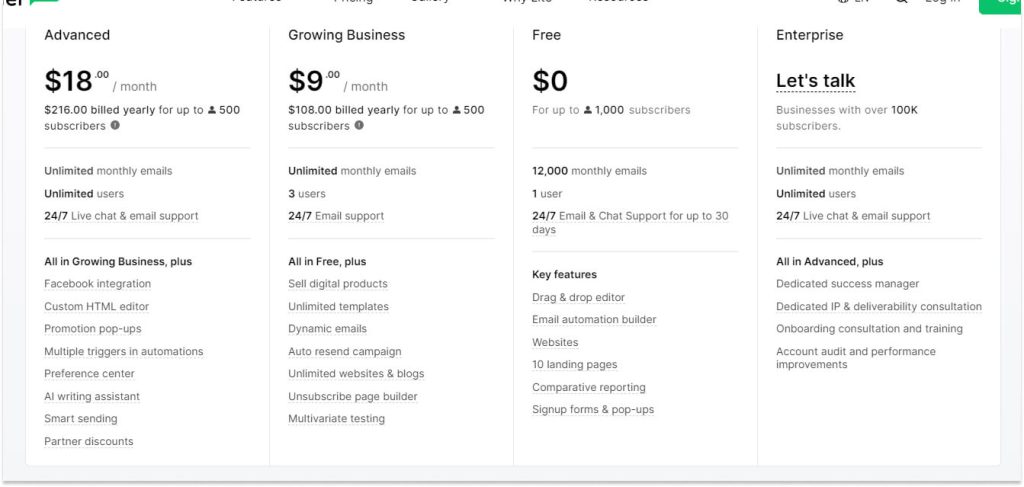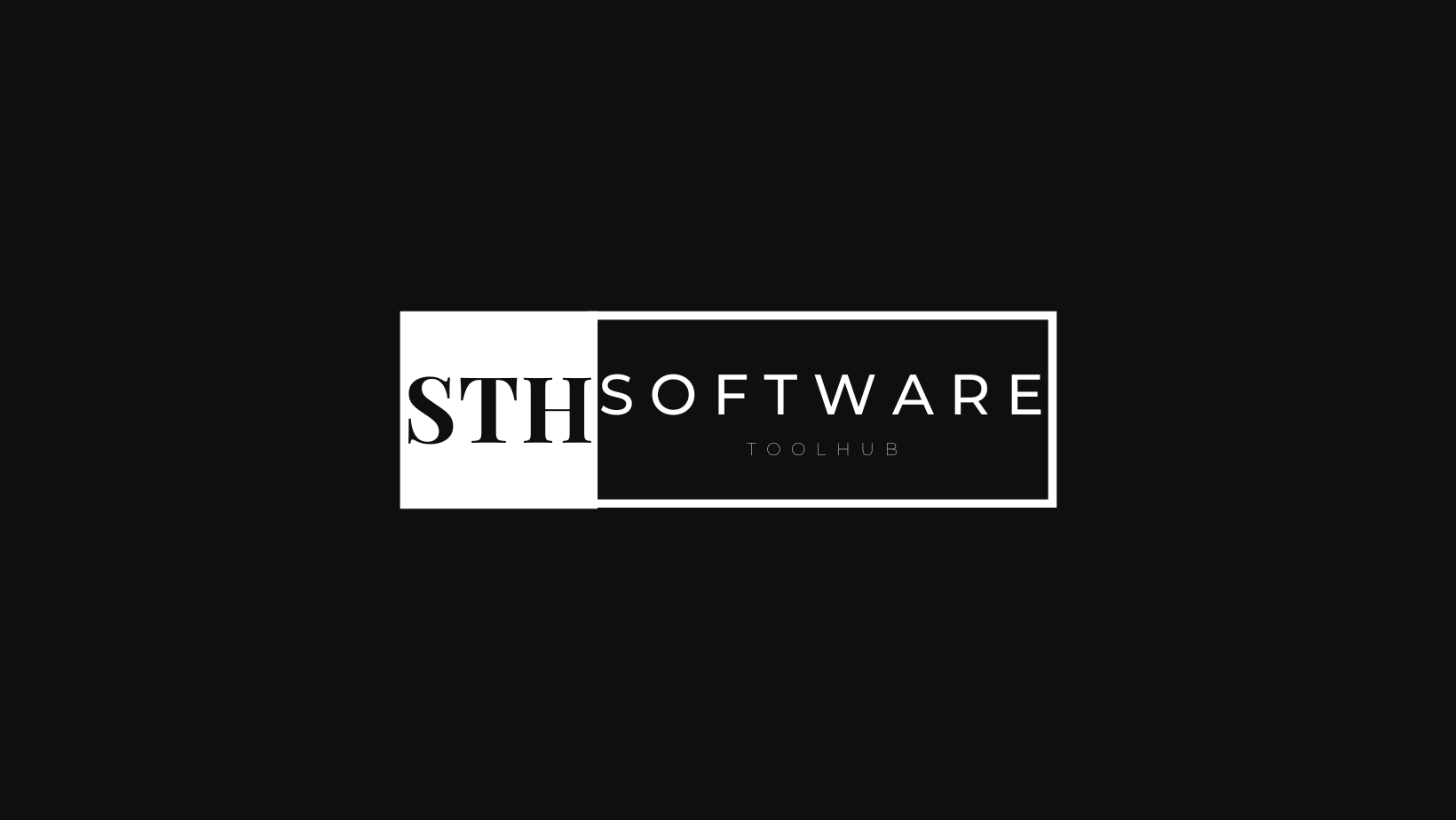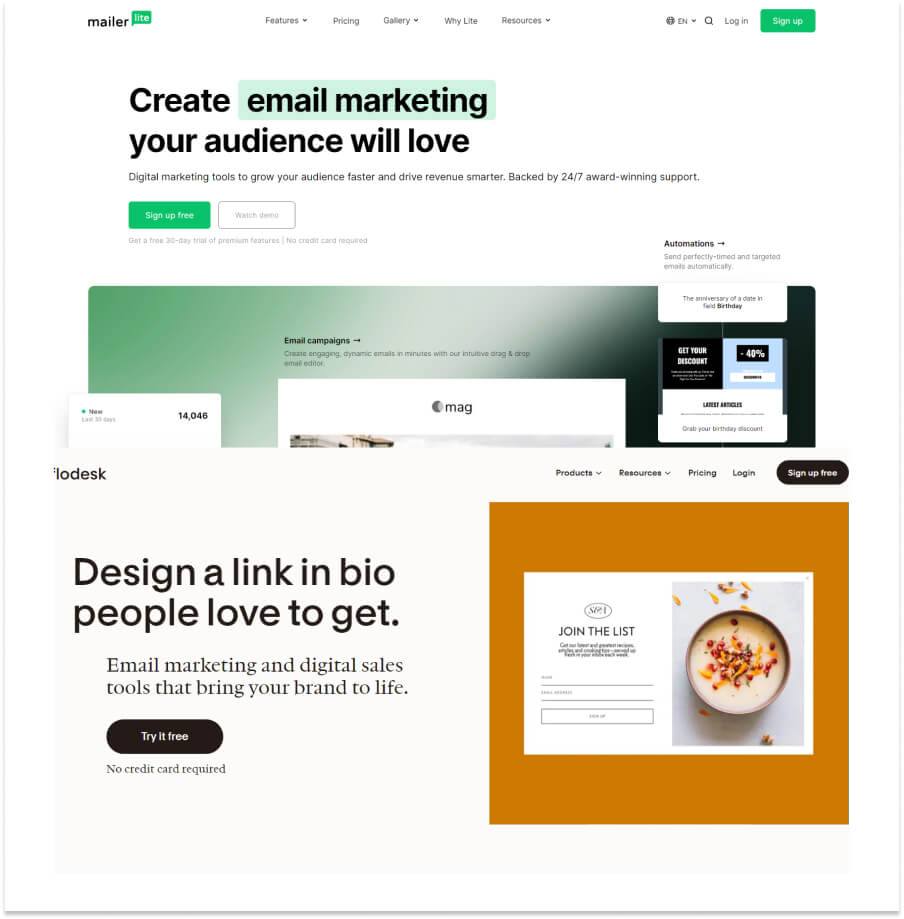MailerLite vs Flodesk which do you need? In the ever-evolving email marketing, choosing the right platform is paramount for businesses aiming to carve a niche in the digital realm. Two contenders, MailerLite vs Flodesk, stand tall in this arena, each boasting a unique set of features. In this comprehensive article, we dissect the strengths and weaknesses of both platforms to guide you in making an informed decision tailored to your specific needs.
Table of Contents
MailerLite vs Flodesk: Key Features for Email Marketing Success
MailerLite Features:
a. Email Automation: One of MailerLite’s standout features is its robust email automation capabilities. Users can create intricate automation workflows, including drip campaigns, to engage subscribers at various stages of the customer journey. The platform’s intuitive automation editor allows for easy customization and management.
b. Drag-and-Drop Builder: MailerLite boasts a user-friendly drag-and-drop builder, empowering even those without extensive design skills to create visually appealing emails. The builder offers a variety of content blocks, making it simple to structure emails and newsletters according to individual preferences.
c. Template Library: With a diverse array of professionally designed templates, MailerLite caters to different industries and campaign objectives. Users can choose from these templates and customize them to align with their brand identity. The platform ensures that templates are responsive, providing a seamless viewing experience across devices.
d. Integration Capabilities: MailerLite offers seamless integration with numerous third-party apps and services. Whether it’s connecting with CRM systems, e-commerce platforms, or other marketing tools, users can enhance their workflow by synchronizing data effortlessly.
e. Cost-Effective Pricing: One notable aspect is MailerLite’s cost-effective pricing structure. The platform provides a free plan for users with smaller subscriber lists, and as the list grows, the pricing remains competitive. This scalability makes it an attractive choice for businesses of all sizes.
Flodesk Features:
a. Stunning Templates: Flodesk takes pride in its visually stunning and modern templates. Designed with a creative edge, these templates stand out, capturing the attention of subscribers. Customization options are abundant, allowing users to create emails that resonate with their brand personality.
b. Simplified User Interface: Known for its elegant and straightforward user interface, Flodesk is often favored by users who prioritize simplicity. The platform’s design is intuitive, making it easy for users to navigate and create campaigns without a steep learning curve.
c. Email Automation Excellence: Flodesk excels in the realm of email automation, offering powerful tools for creating automated sequences. The platform simplifies the process of setting up workflows, making it accessible for users looking to streamline their marketing efforts.
d. Visual Editing Perfection: The visual editor in Flodesk is a standout feature, allowing users to see changes in real-time. This feature is particularly valuable for those who prioritize a visual approach to email creation. Users can experiment with design elements and witness the impact instantly.
e. Transparent Pricing Model: Flodesk operates on a transparent pricing model, offering a flat-rate fee regardless of the subscriber count. This simplicity in pricing appeals to users who prefer a straightforward approach without worrying about escalating costs as their audience grows.
Both MailerLite vs Flodesk offer compelling features, catering to different preferences and requirements. MailerLite stands out for its cost-effective scalability and extensive integration capabilities, while Flodesk shines with its visually appealing templates and user-friendly interface. Ultimately, the choice between the two depends on the specific needs and priorities of the user, whether it’s advanced automation, design aesthetics, or budget considerations. By understanding the key features of each platform, businesses can make an informed decision to propel their email marketing success.
MailerLite vs Flodesk in Ease of Use for Email Marketing
MailerLite: Paving the Way for Simplicity
a. Intuitive Dashboard: MailerLite welcomes users with an intuitive dashboard that provides a clear overview of essential functions. The navigation is designed to be straightforward, allowing users to access features without feeling overwhelmed.
b. Drag-and-Drop Builder: At the heart of MailerLite’s user-friendliness is its drag-and-drop builder. Crafted with simplicity in mind, this tool empowers users to create engaging emails without delving into intricate technicalities. The drag-and-drop functionality ensures a smooth and intuitive design process.
c. Easy Automation Workflow: For users venturing into the world of automation, MailerLite simplifies the process. The automation workflow editor is user-friendly, enabling even those with minimal technical expertise to set up automated email sequences effortlessly.
d. Robust Knowledge Base: Recognizing the importance of support for users, MailerLite provides a robust knowledge base. This resource serves as a go-to guide for users seeking assistance, ensuring that even beginners can navigate the platform confidently.
Flodesk: Crafting Simplicity in Design
a. Elegant Interface: Flodesk prides itself on an elegant and minimalist interface, creating an environment that is visually pleasing and easy to navigate. The platform’s design is geared towards simplicity, making it an attractive choice for users who prioritize a clean and uncluttered workspace.
b. Intuitive Email Editor: At the core of Flodesk’s user-friendly approach is its email editor. The visual editor allows users to witness real-time changes, providing an intuitive and dynamic experience. Users can experiment with design elements and see the impact immediately, fostering a user-friendly design process.
c. Simplified Campaign Creation: Flodesk streamlines the campaign creation process, offering pre-designed, aesthetically pleasing templates. Users can customize these templates effortlessly, making it a suitable choice for those who may not possess advanced design skills.
d. Supportive Learning Resources: Understanding the learning curve for users, Flodesk invests in supportive learning resources. From video tutorials to step-by-step guides, the platform ensures that users can harness its full potential without feeling overwhelmed.
While both MailerLite vs Flodesk prioritize user-friendliness, they do so in distinct ways. MailerLite stands out for its intuitive dashboard and robust knowledge base, providing a solid foundation for users of all levels. On the other hand, Flodesk excels in creating an aesthetically pleasing and visually intuitive environment, making it particularly appealing to those who value design simplicity.
The choice between MailerLite vs Flodesk ultimately hinges on individual preferences and priorities. Businesses seeking a balance between power and simplicity may find MailerLite’s feature-rich yet user-friendly interface a perfect fit. Alternatively, those who lean towards a visually elegant and minimalist design may gravitate towards Flodesk’s seamless and aesthetic user experience. By understanding the nuances of each platform’s user-friendliness, businesses can make an informed decision that aligns with their unique needs and technical comfort levels.
MailerLite vs Flodesk in Templates and Design for Email Marketing
MailerLite: Versatility Meets Customization
a. Extensive Template Library: MailerLite impresses with its extensive template library, catering to a diverse range of industries and campaign objectives. From newsletters to promotional emails, users have access to a plethora of professionally designed templates that serve as an excellent starting point for their campaigns.
b. Drag-and-Drop Customization: One of MailerLite’s standout features is its drag-and-drop builder, allowing users to customize templates with ease. The user-friendly interface ensures that even those without advanced design skills can create visually appealing emails. The customization options are robust, providing flexibility while maintaining simplicity.
c. Responsive Design: MailerLite ensures that templates are not just visually appealing but also responsive. In an era where mobile responsiveness is crucial, MailerLite’s templates automatically adapt to various screen sizes, providing a seamless experience for subscribers on different devices.
d. A/B Testing for Optimization: For users keen on optimizing their campaigns, MailerLite offers A/B testing functionality. This feature allows users to experiment with different template elements, helping them identify the most effective design elements for their audience.
Flodesk: Aesthetic Excellence in Design
a. Visually Stunning Templates: Flodesk distinguishes itself with visually stunning and modern templates. Crafted with a creative edge, these templates are designed to capture the attention of subscribers. Flodesk’s emphasis on aesthetic excellence makes it a go-to choice for users who prioritize visually appealing campaigns.
b. Intuitive Customization: Flodesk’s customization options are intuitive, allowing users to tailor templates to align with their brand identity effortlessly. The platform embraces a visual editing approach, allowing users to see changes in real-time as they customize their emails, providing a dynamic and user-friendly design experience.
c. Design Simplicity: Known for its elegant and minimalist approach, Flodesk’s design simplicity extends to its templates. Users can create sophisticated and visually pleasing emails without the need for intricate design skills. This simplicity ensures that the focus remains on the content and message.
d. Seamless Branding Integration: Flodesk facilitates seamless branding integration, ensuring that users can maintain a consistent brand image across all their email campaigns. This feature is particularly valuable for businesses aiming to reinforce their brand identity through every communication.
Choosing between MailerLite vs Flodesk in the realm of templates and design boils down to individual preferences and marketing goals. MailerLite stands out for its versatile template library and robust customization options, ideal for businesses seeking flexibility and optimization. On the other hand, Flodesk shines in its commitment to aesthetic excellence and design simplicity, making it a preferred choice for those who prioritize visually captivating campaigns.
Businesses should evaluate their design needs, considering factors such as industry aesthetics, brand identity, and the level of customization required. By understanding the nuances of each platform’s approach to templates and design, users can make an informed decision that aligns with their unique vision for email marketing success.
MailerLite vs Flodesk in Integrating Your Marketing Ecosystem
MailerLite: Extensive integration for Enhanced Workflow
a. Diverse Third-Party Integrations: MailerLite stands out for its extensive array of third-party integrations. From customer relationship management (CRM) systems to e-commerce platforms and analytics tools, MailerLite ensures that users can connect their email marketing efforts seamlessly with their existing marketing ecosystem.
b. API Access for Custom Integrations: For users with specific integration needs, MailerLite provides API access. This feature empowers businesses to create custom integrations tailored to their unique requirements, fostering a highly personalized and efficient workflow.
c. WordPress Integration for Website Connectivity: Recognizing the importance of web presence, MailerLite offers a user-friendly WordPress plugin. This integration allows businesses to effortlessly connect their email marketing efforts with their WordPress websites, streamlining the process of capturing leads and nurturing subscribers.
d. E-commerce Compatibility: For businesses operating in the e-commerce space, MailerLite integrates seamlessly with popular e-commerce platforms. This ensures that transactional data, customer information, and marketing efforts are synchronized, providing a holistic view of customer interactions.
Flodesk: Simplified integration for Effortless Operations
a. Strategic Integration Partnerships: Flodesk, while not as extensive as MailerLite, focuses on strategic integration partnerships. The platform ensures that its integrations are well-curated and align with the needs of its user base, creating a streamlined experience for businesses seeking simplicity and efficiency.
b. Direct Connection to Platforms: Flodesk simplifies the integration process by providing direct connections to key platforms. This approach eliminates the need for third-party connectors in many cases, reducing the complexity of the integration process for users who prioritize a straightforward and user-friendly experience.
c. CRM Integration for Enhanced Customer Management: Flodesk places emphasis on customer relationship management, offering integrations with popular CRM systems. This ensures that user data is seamlessly shared between platforms, allowing businesses to maintain a centralized view of customer interactions and preferences.
d. Smooth Website Integration: Flodesk facilitates website integration with ease. Users can embed forms and capture leads directly on their websites, fostering a cohesive connection between email marketing efforts and online presence.
The decision between MailerLite vs Flodesk in terms of integration capabilities ultimately hinges on the specific needs and priorities of the business. MailerLite’s extensive integration options make it a powerhouse for businesses seeking a highly connected and customizable marketing ecosystem. On the other hand, Flodesk appeals to users who value simplicity and strategic integrations that align closely with their operational needs.
Businesses should assess their existing toolset, future scalability requirements, and the level of customization needed. By understanding the nuances of each platform’s approach to integration, users can select the solution that serves as the optimal connective tissue for their unique marketing landscape. Whether it’s the robust connectivity of MailerLite or the streamlined simplicity of Flodesk, the right choice can pave the way for a more efficient and interconnected marketing strategy.
MailerLite vs Flodesk – Pricing Structures for Email Marketing Success
When comparing MailerLite vs Flodesk, the pricing plans are a crucial factor to consider. Flodesk offers a flat rate of $35 per month, regardless of the number of subscribers, while MailerLite’s pricing is based on the number of subscribers, with plans starting at $9 per month for up to 1,000 subscribers. However, it’s important to note that Flodesk offers unlimited emails and automations, whereas MailerLite’s lower-tier plans have email sending limits. Therefore, the choice between the two will depend on the specific needs and budget of your business.


People also read:
ConvertKit vs TinyEmail : A Comprehensive Comparison
AWeber vs TinyEmail: Making the Right Choice
MailerLite: Scalable Affordability for Growing Businesses
a. Free Plan for Small Subscribers: One of MailerLite’s standout features is its commitment to accessibility. The platform offers a free plan for users with smaller subscriber lists, allowing startups and small businesses to harness the power of email marketing without incurring initial costs.
b. Transparent Scaling with Subscriber Growth: As subscriber lists grow, MailerLite’s pricing remains transparent and competitive. The platform employs a tiered pricing model, ensuring that users pay based on the size of their subscriber base. This scalability makes MailerLite an attractive option for businesses with evolving email marketing needs.
c. Feature-Rich Plans for Advanced Users: MailerLite offers feature-rich paid plans that cater to the needs of advanced users. These plans include additional functionalities such as advanced automation, A/B testing, and custom branding. Businesses can choose a plan that aligns with their specific requirements and budget.
d. No Hidden Costs or Surprise Fees: MailerLite is known for its straightforward pricing approach. Users can confidently plan their budgets as there are no hidden costs or surprise fees. The transparency in pricing ensures that businesses can allocate resources effectively without unexpected financial burdens.
Flodesk: Flat-Rate Simplicity Regardless of Subscriber Count
a. Flat-Rate Pricing Model: Flodesk takes a unique approach with its flat-rate pricing model. Unlike tiered pricing structures, Flodesk users pay a consistent fee regardless of the size of their subscriber list. This simplicity in pricing appeals to businesses seeking predictability and ease of budgeting as their audience grows.
b. Inclusive Access to All Features: Flodesk’s flat-rate pricing provides users with inclusive access to all features, irrespective of the chosen plan. This approach eliminates the need to upgrade plans to unlock specific functionalities, offering a straightforward and inclusive user experience.
c. No Upselling or Hidden Charges: Flodesk stands out for its commitment to transparency. Users do not encounter upselling attempts or hidden charges. The pricing model ensures that businesses can leverage the platform’s full capabilities without being caught off guard by unexpected costs.
d. Budget-Friendly for Growing Businesses: Flodesk’s flat-rate pricing makes it an attractive choice for growing businesses. As subscriber lists expand, businesses can continue to utilize the platform’s features without the fear of escalating costs. This predictability in pricing allows businesses to focus on their email marketing strategies with confidence.
Choosing between MailerLite vs Flodesk in terms of pricing structure involves a careful consideration of budgetary constraints and business growth projections. MailerLite’s scalable pricing model caters to businesses at different stages, offering affordability and advanced features. On the other hand, Flodesk’s flat-rate simplicity provides predictability, making it an appealing option for businesses seeking a consistent and inclusive pricing experience.
Businesses should assess their current subscriber base, projected growth, and feature requirements when making a decision. By understanding the nuances of each platform’s pricing structure, users can align their budgets with their email marketing ambitions, setting the stage for a successful and cost-effective marketing strategy.
MailerLite vs Flodesk – A Deep Dive into Email Deliverability
1. MailerLite: Ensuring Inbox Success with Proven Strategies
a. Dedicated Deliverability Team: One of MailerLite’s strengths lies in its dedicated deliverability team. This team works diligently to optimize email delivery rates by staying abreast of industry best practices, monitoring sender reputation, and proactively addressing potential deliverability issues.
b. Compliance with Email Regulations: MailerLite places a strong emphasis on compliance with email regulations, including GDPR. By adhering to these standards, the platform ensures that users’ emails not only reach the inbox but also maintain a positive sender reputation, a crucial factor in email deliverability.
c. A/B Testing for Optimization: Understanding the importance of continuous improvement, MailerLite offers A/B testing functionality. Users can experiment with different email elements to identify the most effective combinations, thereby enhancing engagement and positively impacting deliverability rates.
d. Real-Time Analytics for Monitoring: To empower users with insights into their email performance, MailerLite provides real-time analytics. This feature allows users to monitor key metrics, track engagement, and make data-driven decisions to further improve deliverability over time.
2. Flodesk: Prioritizing User-Friendly Deliverability
a. Simplified Design for Engagement: Flodesk adopts a user-friendly design approach that inherently promotes engagement. By offering visually stunning templates and a straightforward email editor, Flodesk aims to create emails that not only captivate subscribers but also contribute to higher engagement rates, positively influencing deliverability.
b. Engagement-Based Segmentation: Flodesk introduces a unique approach to segmentation based on engagement levels. Users can target specific segments of their audience based on interactions with previous emails. This engagement-based segmentation can enhance deliverability by tailoring content to the preferences of different subscriber groups.
c. Comprehensive Learning Resources: Recognizing the impact of user knowledge on deliverability, Flodesk invests in comprehensive learning resources. Users can access video tutorials and guides that provide insights into best practices, helping them optimize their email campaigns for improved deliverability.
d. Responsive Customer Support: Flodesk offers responsive customer support, ensuring that users have access to assistance when facing deliverability challenges. The platform’s support team can provide guidance on best practices, troubleshooting, and other factors influencing email deliverability.
While both MailerLite vs Flodesk prioritize email deliverability, they approach it from different angles. MailerLite’s dedicated deliverability team, compliance efforts, and A/B testing contribute to a robust strategy for ensuring emails reach the inbox. On the other hand, Flodesk emphasizes user-friendly design, engagement-based segmentation, and comprehensive learning resources to enhance deliverability.
Businesses should consider their specific needs, preferences, and levels of technical expertise when selecting a platform. Whether opting for MailerLite’s data-driven approach or Flodesk’s user-centric strategy, the goal is to navigate the inbox landscape successfully and ensure that email campaigns effectively reach the intended audience. Understanding the nuances of each platform’s approach to deliverability is key to making an informed decision that aligns with the unique goals of the business.
MailerLite vs Flodesk – A Comprehensive Look at Customer Support
1. MailerLite: Fostering User Success with Responsive Assistance
a. Multichannel Support: MailerLite stands out with its commitment to providing support through multiple channels. Users can access assistance through email, live chat, and a comprehensive knowledge base. This multichannel approach ensures that users can choose the mode of support that best fits their needs and preferences.
b. 24/7 Availability for Premium Users: For users who require round-the-clock support, MailerLite offers 24/7 availability for premium users. This ensures that businesses operating in different time zones or those with urgent queries can receive timely assistance, contributing to a seamless user experience.
c. Community Forums for Collaboration: In addition to direct support channels, MailerLite fosters a sense of community among its users. Community forums provide a platform for users to collaborate, share insights, and seek advice from peers. This collaborative approach enhances the overall support ecosystem for MailerLite users.
d. Personalized Onboarding for New Users: Recognizing the importance of a smooth onboarding process, MailerLite offers personalized onboarding assistance for new users. This guided introduction helps users navigate the platform effectively, reducing the learning curve and ensuring a positive initial experience.
2. Flodesk: Prioritizing Simplicity and Accessibility in Support
a. Responsive Email Support: Flodesk focuses on providing responsive email support to its users. This direct communication channel allows users to submit queries and receive timely assistance. The platform aims to address user concerns promptly, contributing to a positive and supportive user experience.
b. Resourceful Help Center: Flodesk invests in a resourceful help center, offering users access to a variety of guides, tutorials, and frequently asked questions. This self-help resource is designed to empower users with the knowledge needed to navigate the platform independently and troubleshoot common issues.
c. Video Tutorials for Visual Learning: Understanding the diverse learning preferences of users, Flodesk offers video tutorials as part of its support resources. These visual guides provide step-by-step instructions, making it easier for users to grasp concepts and features, particularly beneficial for those who prefer visual learning.
d. Growing Knowledge Base: As Flodesk continues to evolve, its knowledge base grows to accommodate new features and user queries. This commitment to updating and expanding the knowledge base ensures that users have access to relevant and up-to-date information, contributing to ongoing self-learning and support.
Customer support is a vital pillar in the user experience journey, and both MailerLite vs Flodesk prioritize user assistance in their own ways. MailerLite’s multichannel support, 24/7 availability for premium users, community forums, and personalized onboarding cater to diverse user needs. Flodesk, on the other hand, emphasizes responsive email support, a resourceful help center, video tutorials, and a growing knowledge base to foster user success.
Businesses should consider their preferences, the level of support needed, and their preferred learning styles when choosing between MailerLite vs Flodesk. Whether opting for the collaborative community approach of MailerLite or the resourceful self-help focus of Flodesk, the goal is to ensure that users receive the necessary support to maximize their success on the platform. Understanding the nuances of each platform’s customer support strategy is crucial for businesses seeking a supportive partner in their email marketing endeavors.
MailerLite vs Flodesk – Unveiling Analytics and Reporting Features
1. MailerLite: Empowering Users with Comprehensive Analytics
a. Real-Time Reporting: MailerLite empowers users with real-time reporting capabilities. This feature allows users to monitor the performance of their email campaigns as it unfolds, providing immediate insights into open rates, click-through rates, and other key metrics. Real-time reporting is invaluable for those who seek to make data-driven decisions promptly.
b. Click Maps for Visual Engagement Data: Understanding that visual data can be powerful, MailerLite offers click maps. These visual representations showcase where subscribers are clicking within an email, enabling users to identify hotspots of engagement. Click maps contribute to a deeper understanding of subscriber behavior and preferences.
c. Segmentation for Targeted Analysis: To facilitate targeted analysis, MailerLite provides segmentation options within its analytics. Users can segment their audience based on various parameters, allowing for a granular examination of campaign performance across different subscriber groups. This segmentation enhances the precision of data analysis.
d. Conversion Tracking for Goal Measurement: For businesses with specific conversion goals, MailerLite offers conversion tracking. This feature allows users to track and measure the success of defined goals, such as product purchases or sign-ups. Conversion tracking provides valuable insights into the effectiveness of email campaigns in driving desired actions.
2. Flodesk: Simplifying Insights with Intuitive Analytics
a. Overview Dashboard for Quick Insights: Flodesk simplifies the analytics experience with an overview dashboard. This centralized hub offers a quick snapshot of key metrics, including open rates and click-through rates. The user-friendly design ensures that users can access essential insights at a glance, making it an ideal starting point for analysis.
b. Visual Representation of Engagement Trends: Understanding the significance of visual data, Flodesk provides visual representations of engagement trends over time. Users can track how engagement metrics evolve, identifying patterns and trends that can inform future email marketing strategies. Visual engagement trends contribute to a more intuitive understanding of campaign performance.
c. Subscriber Growth Tracking: Flodesk includes features for tracking subscriber growth. Users can monitor how their subscriber base evolves over time, identifying periods of growth or potential areas for improvement. Subscriber growth tracking is particularly valuable for businesses looking to assess the impact of their marketing efforts on audience expansion.
d. Open Rate and Click Rate Analytics: Flodesk places a focus on essential metrics such as open rates and click rates. Users can delve into detailed analytics for these key performance indicators, gaining insights into how subscribers interact with their emails. Analyzing open rate and click rate data allows for targeted adjustments to boost engagement.
Both MailerLite vs Flodesk offer robust analytics and reporting features, each with its own strengths. MailerLite stands out for its real-time reporting, click maps, segmentation, and conversion tracking, providing users with comprehensive tools for in-depth analysis. On the other hand, Flodesk prioritizes simplicity with its overview dashboard, visual engagement trends, subscriber growth tracking, and detailed analytics on open rates and click rates.
When choosing between MailerLite vs Flodesk, businesses should consider their specific analytical needs, preferences for data presentation, and the level of granularity required for decision-making. Whether opting for the comprehensive analytics suite of MailerLite or the streamlined and visually intuitive approach of Flodesk, the goal is to empower users with the insights needed to refine and optimize their email marketing strategies. Understanding the nuances of each platform’s analytics and reporting features is key to making an informed decision aligned with the goals of the business.
MailerLite vs. Flodesk – A Deep Dive into Security and Compliance
1. MailerLite: Prioritizing Data Security and Compliance Measures
a. GDPR Compliance and Beyond: MailerLite places a strong emphasis on compliance with data protection regulations, notably the General Data Protection Regulation (GDPR). The platform is designed to align with GDPR principles, ensuring that user data is handled with transparency, lawfulness, and fairness. MailerLite’s commitment extends beyond GDPR to encompass other relevant data protection regulations.
b. Secure Data Storage: Security is paramount in MailerLite’s approach to data management. The platform employs secure data storage practices to safeguard user information. Measures such as encryption protocols and regular security audits contribute to a robust defense against potential threats and breaches.
c. Two-Factor Authentication for Account Security: To enhance account security, MailerLite provides the option for two-factor authentication. This additional layer of protection ensures that only authorized individuals can access and manage account settings. Two-factor authentication is a proactive measure to mitigate the risk of unauthorized access.
d. Transparent Privacy Policy: MailerLite maintains a transparent privacy policy that outlines how user data is collected, processed, and stored. The clarity of the privacy policy empowers users with the information needed to make informed decisions about their data and privacy. Transparency is a key element in building trust with users.
2. Flodesk: Streamlined Security Measures with a Focus on Transparency
a. GDPR Compliance and User Consent: Flodesk, like MailerLite, is committed to GDPR compliance. The platform ensures that user consent is prioritized, and data processing activities align with the principles of GDPR. By obtaining clear and informed consent, Flodesk establishes a foundation of trust with its users.
b. Secure Hosting Infrastructure: Flodesk’s approach to data security includes a secure hosting infrastructure. The platform invests in secure hosting solutions to protect user data from potential vulnerabilities. This commitment to a secure foundation contributes to the overall integrity of user information.
c. Privacy-Centric Policies: Flodesk maintains privacy-centric policies that inform users about how their data is handled. By clearly articulating data practices, Flodesk enables users to understand the platform’s commitment to protecting their privacy. Transparent policies contribute to a sense of security and confidence among users.
d. Regular Security Audits: Flodesk conducts regular security audits to assess and fortify its defense mechanisms against evolving threats. These proactive audits ensure that the platform remains vigilant in identifying and addressing potential vulnerabilities. Regular security assessments are crucial for maintaining a high level of data protection.
MailerLite vs Flodesk both prioritize data protection and compliance, implementing measures to secure user information and adhere to regulatory frameworks. MailerLite distinguishes itself with its comprehensive GDPR compliance, secure data storage, two-factor authentication, and transparent privacy policy. Flodesk, on the other hand, emphasizes GDPR compliance, secure hosting infrastructure, privacy-centric policies, and regular security audits.
When choosing between MailerLite vs Flodesk, businesses should consider their specific data protection needs, the level of transparency required, and the importance of compliance with regulations such as GDPR. Whether opting for the comprehensive data protection measures of MailerLite or the streamlined security focus of Flodesk, the goal is to instill trust and confidence in users regarding the safety and privacy of their data. Understanding the nuances of each platform’s approach to data protection is key to making an informed decision aligned with the security priorities of the business.
MailerLite vs. Flodesk – Exploring Scalability for Growing Businesses
1. MailerLite: A Platform Tailored for Scalability
a. Tiered Pricing Model for Versatile Scaling: MailerLite adopts a tiered pricing model that aligns with the size and needs of businesses. This scalability allows users to choose a plan based on their current requirements and easily transition to a higher tier as their subscriber base expands. The tiered structure ensures that businesses only pay for the features and capacity they need.
b. Robust Automation for Efficient Scaling: Automation is a key driver of scalability, and MailerLite excels in this regard. The platform provides robust automation features that empower businesses to scale their email marketing efforts efficiently. Whether it’s setting up automated workflows or drip campaigns, MailerLite’s automation capabilities accommodate the evolving needs of growing businesses.
c. Responsive Customer Support for Timely Assistance: As businesses scale, the need for responsive customer support becomes paramount. MailerLite addresses this by offering multichannel support, including live chat and email assistance. Premium users benefit from 24/7 support, ensuring timely assistance regardless of the business’s operating hours or time zones.
d. Scalable Template Library and Design Tools: MailerLite’s template library and design tools are crafted to accommodate scalability. With a diverse range of templates and a user-friendly drag-and-drop builder, businesses can maintain a consistent and visually appealing brand image even as they scale their email marketing campaigns to reach larger audiences.
2. Flodesk: Streamlining Scalability with User-Friendly Features
a. Flat-Rate Pricing for Predictable Scaling: Flodesk adopts a flat-rate pricing model, simplifying the scalability process. Users pay a consistent fee regardless of the size of their subscriber list. This flat-rate structure provides predictability, allowing businesses to plan their budgets with confidence as they scale up their email marketing efforts.
b. Intuitive Email Editor for Seamless Scaling: Flodesk’s intuitive email editor is designed to streamline the scaling process. With a user-friendly interface, businesses can easily create and customize emails as they grow their subscriber base. The platform’s focus on simplicity ensures that even users without advanced design skills can maintain a polished and scalable email marketing strategy.
c. Subscriber Growth Tracking for Informed Scaling: Flodesk includes features for tracking subscriber growth over time. Businesses can monitor how their audience expands and use this data to make informed decisions about scaling their email marketing efforts. Subscriber growth tracking provides valuable insights for businesses seeking to adapt to changing audience sizes.
d. Visual Analytics for Scalability Insights: Understanding the importance of analytics in scaling, Flodesk provides visual representations of engagement trends. These insights enable businesses to understand how their email campaigns are performing as they scale, allowing for data-driven adjustments to optimize results.
Both MailerLite vs Flodesk recognize the significance of scalability for growing businesses and provide features that cater to this need. MailerLite’s tiered pricing, robust automation, responsive customer support, and scalable design tools make it a versatile choice for businesses at various stages of growth. Flodesk’s flat-rate pricing, intuitive email editor, subscriber growth tracking, and visual analytics offer a streamlined approach for businesses seeking simplicity and predictability as they scale.
When choosing between MailerLite vs Flodesk, businesses should assess their current size, growth projections, budget considerations, and the level of flexibility needed in their email marketing strategy. Whether opting for the versatile scalability of MailerLite or the streamlined simplicity of Flodesk, the goal is to choose a platform that aligns with the unique scaling goals and requirements of the business. Understanding the nuances of each platform’s approach to scalability is essential for making an informed decision that sets the stage for successful email marketing growth.
Mailerlite vs Flodesk : Pros and Cons
MailerLite:
Pros:
- Affordability: MailerLite is known for its cost-effectiveness, especially for small businesses or those on a tight budget.
- Ease of Use: The platform offers a user-friendly interface with drag-and-drop functionality, making it accessible for users with varying levels of technical expertise.
- Automation: MailerLite provides robust automation features, allowing users to set up workflows, autoresponders, and targeted email campaigns.
- A/B Testing: The platform supports A/B testing, enabling users to optimize their email campaigns by experimenting with different subject lines, content, or send times.
- Responsive Templates: MailerLite offers responsive email templates that look good on various devices, helping improve the overall user experience.
Cons:
- Advanced Features Limitation: Some advanced features available in other email marketing tools might be lacking in MailerLite, limiting its suitability for larger enterprises with complex needs.
- Customer Support: While MailerLite does provide customer support, some users may find it less responsive or comprehensive compared to other platforms.
Flodesk:
Pros:
- Visual Appeal: Flodesk is known for its visually stunning and highly customizable email templates, making it a great choice for those who prioritize aesthetics.
- Intuitive Design: The platform offers an intuitive and easy-to-navigate interface, making it a good fit for users who want a straightforward experience in creating email campaigns.
- Segmentation: Flodesk provides advanced segmentation features, allowing users to target specific audience segments with personalized content.
- No Pricing Tiers: Flodesk offers a flat-rate pricing structure, which can be advantageous for businesses experiencing rapid growth as they won’t face increased costs with a growing subscriber list.
- Customer Support: Flodesk is often praised for its responsive and helpful customer support, providing assistance when users encounter issues or have questions.
Cons:
- Cost: While the flat-rate pricing can be an advantage, some users might find Flodesk to be more expensive than other options, particularly for those with smaller subscriber lists.
- Learning Curve: Users who are new to email marketing may find the customization options and features in Flodesk a bit overwhelming initially.
- Integration Limitations: Flodesk may have limitations in terms of integrations with other third-party tools and platforms compared to more established email marketing services.
Conclusion
In the battle of MailerLite vs Flodesk, there is no clear winner; it depends on your specific requirements. Whether you prioritize budget-friendliness and simplicity or eye-catching designs and advanced automation, both platforms have their merits. Take the time to analyze your needs, and you’ll find the platform that aligns seamlessly with your email marketing goals. Happy emailing




